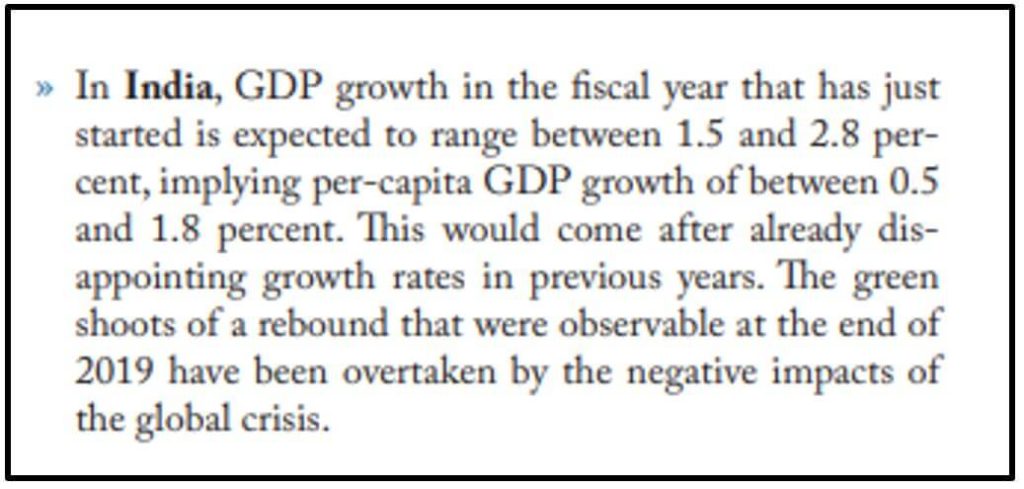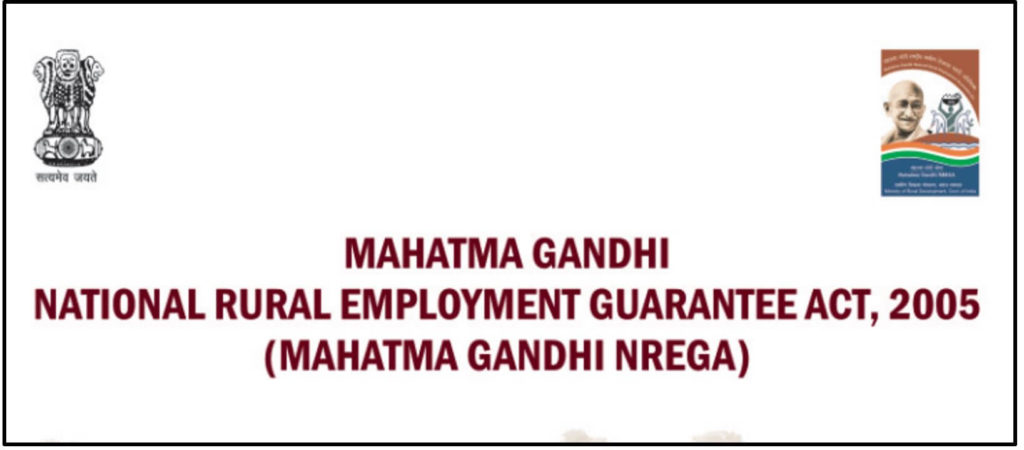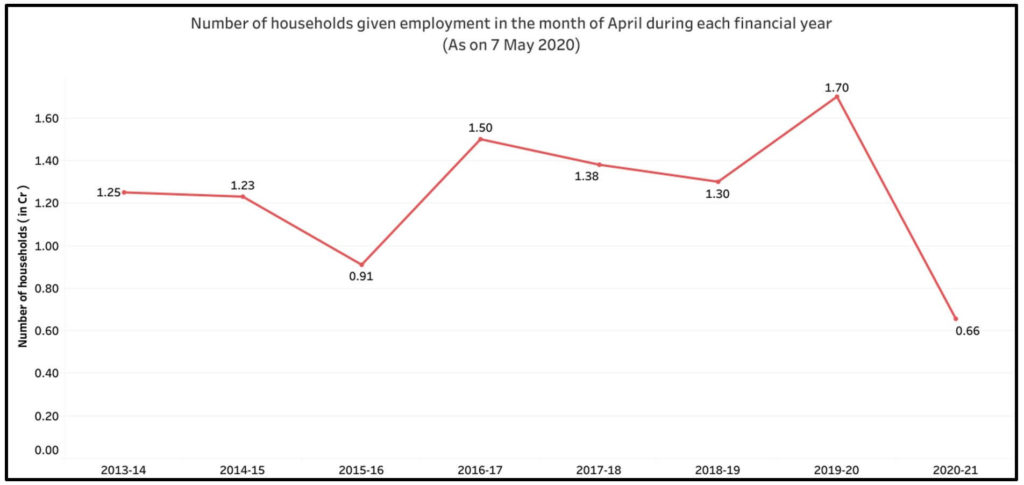The ongoing lockdown in the country has affected many sectors. Though activities in the rural areas began in 2nd half of April, the impact of the lockdown was visible. Compared to April 2019, less than 40% the households worked under the NREGS in April 2020.
The nationwide lockdown was announced by Prime Minister Narendra Modi on 24 March 2020, initially for a period of 21 days, to check the spread of COVID-19. However, now the lockdown has been extended to 54 days, up to 17 May 2020 with certain relaxations. The unprecedented crisis has brought the whole country to a standstill. Except for essential services, most of the economic activities have been halted temporarily for an indefinite period of time. The impact of this move on the Indian economy is a widely discussed topic these days.
The World Bank’s South Asia Economic Focus, Spring 2020 report projects India’s GDP growth in 2020-21 to be between 1.5 to 2.8% as a result of the collapse in economic activities because of COVID-19.

More than half of the global workforce are at risk of job-loss as per ILO
There is widespread apprehension of lay-offs, job loss, and hiring freeze across sectors. The International Labour Organization has been constantly monitoring the situation world-wide. ILO’s study has revealed that job loss has escalated globally. Furthermore, the study says that as an impact of the lockdown and loss of employment in hardest-hit sectors, more than 50% of the global workforce, around 1.6 billion workers, engaged in the informal economy are highly vulnerable to job loss. Therefore, ILO has urged governments across the globe to take necessary actions to deal with the ongoing and future situations of job crisis due to the pandemic.
CMIE data indicates unemployment in India was highest at 27.1% as of 03 May 2020
According to the Centre for Monitoring Indian Economy, a think-tank based in Mumbai, as of 03 May 2020, unemployment rate in India surged to a peak and stood at 27.1%. The figure is expected to worsen as the lockdown is extended. Labour participation rate, which represents a country’s active workforce, has also risen to 36.2%, according to the report. Through the consumer pyramids households survey conducted by CMIE, the company has estimated that employment fell by 114 million in April 2020 in India. The employment figures, as per CMIE are the lowest in the last four years from when it started collating such data.
Small traders and daily wage labourers are among the worst affected because of the lockdown. Their employment has fallen significantly, from an average of 128 million in 2019-20, to 116 million in March 2020 and mere 37 million in April 2020, as per CMIE. However, the count of farmers during this period has increased by 6 million.
More and more people return to Rural India
Loss of livelihoods and return of migrant workers to their villages has now created the need for more work in rural India. The Mahatma Gandhi National Rural Employment Guarantee Act, 2005, also popularly known as MNREGA, is a social security scheme implemented by the Ministry of Rural Development together with state governments. The legislation guarantees 100 days of wage employment in a financial year, to adult members in a rural household who are willing to do unskilled manual work at a fixed minimum wage. Activities under MNREGA were also suspended among other activities, during the initial phase of the lockdown. However, works under the scheme were allowed from 20 April 2020.

In the ongoing financial year 2020-21, 66.2 lakh households have been provided work till date.
Number of households registered under the scheme increased by 10% in 7 years
The number of households that have registered for employment under MNREGA has increased from 12.97 crore households in 2013-14 to 14.29 crore households in 2020-21, an increase of about 10% in seven years. However, not all those households that have registered get work. On an average, around 37% of the households are provided work under the scheme. The financial year 2016-17 saw the largest percentage of households given work i.e. 39% of the total registered households. In the current financial year of 2020-21 which is only a month old, work was provided to only 66.2 Lakh households, approximately 4% of the total registered households.

April 2020 had reported the least activity under MNREGA in the last eight financial years due to lockdown
In the second half of March 2020, when few states such as Telangana and Kerala imposed lockdown at the state level, MNREGA activities were disrupted. The works were also not allowed in the last week of March when a nation-wide lockdown was imposed. Despite these disruptions, more than 1.5 crore households were provided work in the month of March 2020. However, in the following month of April 2020, the number of households provided work decreased by a whopping 61% because of the lockdown.
Over the past eight financial years for which data is available, lowest number of households were provided work in April 2020. This is primarily due to the lockdown when the works were not allowed in the first half of April. Since April 2019 reported the highest number of households getting work in 8 years, the decrease in April 2020 is about 61%. The works under the scheme were allowed from 20 April 2020.

Andhra Pradesh and Chhattisgarh together accounted for half the number in April 2020
It is interesting to observe that in April 2020, almost 46.4% of the households who were provided work were from the states of Andhra Pradesh and Chhattisgarh. Of the 65.6 lakh households, 18.3 lakh households were from Andhra Pradesh and 12.2 lakh households were from Chhattisgarh.
Even in April 2019, Andhra Pradesh accounted for the largest number of households provided work with 15% of national total. Andhra Pradesh and Chhattisgarh together contributed to 21% of national total in April 2019. Tamil Nadu, Rajasthan and Telangana had reported work to most households in that order in April 2019. However, Telangana did not report providing work to any household while 17 states and union territories reported providing work to less than one lakh households each. Rajasthan and Tamil Nadu reported providing work to 2.63 lakh and 1.62 lakh households respectively in April 2020.
North East States account for almost half the households reported in May, till date
Data for May 2020, as on date, shows that 88,985 households were provided work. Around 25,800 households were in Assam, followed by 15,995 households in Tripura. North eastern states of Assam, Tripura, Meghalaya, Manipur, Arunachal Pradesh, and Sikkim, alone account for 48.8% of the households given work in May. Mizoram and Nagaland have not reported providing work to any household. One has to wait for the full data of May to understand the impact of the lockdown.
MNREGA activities to continue prioritizing water conservation related work, outside containment zones
During the second phase of lockdown, the Central Government notified guidelines to re-start some economic activities in areas outside containment zones. It was announced that MGNREGS works could also be resumed from 20 April 2020 provided that the social distancing is strictly followed, and all workers wear masks. The government has asked states/UT governments to prioritize irrigation and water conservation works such as construction of check dams, canals, gully plugs, farm ponds, recharge pits, and other similar water harvesting techniques. The Centre might have highlighted this in the light the upcoming monsoon season. Additionally, works listed in ‘Permissible Works List’ under Schedule 1 of MNREGA Act are also permitted like agriculture and allied sector related works, and rural drinking water and sanitation related works.

An increase in daily wage by Rs.20 was announced under COVID relief package
The daily minimum wage for MNREGA workers was raised from Rs.182 to Rs. 202. The announcement was made by Finance Minister Nirmala Sitharaman while announcing a Rs.1.7 Lakh Crore relief package under the Pradhan Mantri Garib Kalyan Yojana.
Rural Development Minister Narendra Singh Tomar announced on 30 April 2020 that the ministry has sanctioned Rs. 33,000 crores under MNREGA, out of which Rs. 20,624 crores have been released to liquidate all outstanding dues of previous years.
Plea in the Supreme Court to pay minimum wages to workers during lockdown
There has been a demand by activists to compensate daily wage labourers during this period of national distress, so that they can make their ends meet. A PIL was filed in the Supreme Court asking the government to pay the migrant workers at least the minimum wage. Furthermore, some state governments have reportedly announced aids for MNREGA workers while activities have resumed in some parts of the country amidst the lockdown.
Despite the government asking employers to refrain from salary cuts or lay- offs, the situation on the ground is different with cashflow difficulties of SME employers. Considering the dominance of unorganized sector in India, the government will have to come up with a comprehensive economic package to mitigate the issues faced by MSMEs.
Featured Image: Lockdown Effect on NREGS


